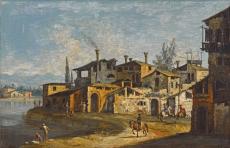


of Michele Marieschi (1710-1743), Canaletto’s most able competitor in the production of Venetian view paintings until his premature death, and they were accepted as such by Mario Manzelli, judging from photographs. Manzelli indeed considered the first painting to be the prototype ‘of a series of ten versions of the same subject, with slight variations of detail’; he attributed the other nine versions to Marieschi’s pupil Francesco Albotto, including paintings in the Museo del Castello Sforzesco, Milan, and with Frost & Reed, London, in 1970. To those may be added a version which differs in some details from all the others. The A. G. Leventis Foundation paintings (opposite and p. 159) are, however, omitted from Marieschi’s oeuvre by the authors of the other recent catalogues of his work, Ralph Toledano and Filippo Pedrocco, and on qualitative grounds this verdict is unquestionably correct. Although he was relatively prolific given the brevity of his activity, Marieschi’s paintings are of a consistently high standard, and his distinctive touch is not evident here. Eugenia Bianchi has stated that the first composition reflects a lost work by Marieschi, which seems very plausible. The shortcomings of the pendant are even more apparent, as in this case a version entirely characteristic of Marieschi is known, admittedly with some differences, notably the figures, which from photographs seem to have been supplied by Marieschi’s frequent collaborator Francesco Simonini (1686 – after 1753). There is also a smaller variant by Marieschi, with a tower crowning the group of buildings and two sailing boats.
Marieschi’s work gave rise to a considerable body of imitations, possibly at least in part because, of very humble origins and with a picture dealer as a father-in-law, he worked in the Venetian artistic community in a way that many of his competitors, such as the more patrician Canal family, did not. The best of these are generally presumed to be the work of Albotto, who was living in Marieschi’s house before the latter’s marriage in November 1737 and who married his master’s widow in 1744. According to Pierre-Jean Mariette, he became known as ‘the second Marieschi’,7 but only one certain work is known, a view of The Molo from the Bacino di San Marco with a signature or inscription on the reverse recorded as F. Albotto F. in Cale di Ca’ Loredan S. Luca.8 That painting is not among the finer Marieschi imitations, some of which, notably some views on the Grand Canal, are close enough to the master’s style to make differentiation more problematical. In the absence of further certain works, it is obviously impossible to establish the qualitative boundaries of Albotto’s output, and it should be noted that his career was only slightly longer than his master’s. Furthermore, capriccios by the hand generally presumed to be Albotto’s were often closely imitated by his associate known as ‘The Master of the Langmatt Foundation Views’, who was active in Venice from the 1740s to the 1770s. Thus, any attribution to Albotto should be made with reservations, but similarities between the Leventis Collection paintings and works generally presumed to be by Albotto make the attribution at least probable.
He was a pupil of Michele Marieschi in Venice and, like him, produced Venetian view paintings. In 1744 he married Marieschi’s widow and took over his studio. Because of the similarity in style to the work of his master, it can be difficult to distinguish their works.